Clinical Leadership and Management: Review of Four Articles
VerifiedAdded on 2021/02/19
|14
|2681
|183
Report
AI Summary
This report provides a critical review of four peer-reviewed journal articles focusing on clinical leadership and management within healthcare settings. The articles explore the significance of clinical leadership in nursing, highlighting its impact on patient care, professional efficiency, and the improvement of healthcare services. The review examines various leadership styles, including transformational and authentic leadership, and their influence on organizational culture, teamwork, and the reduction of clinical errors. The report emphasizes the need for intentional leadership approaches, reflective practices, and the integration of ethical considerations to enhance patient outcomes and create a positive healthcare environment. It also discusses the importance of education, training, and the recognition of leadership strategies to foster effective leadership within healthcare teams. Overall, the report concludes that appropriate clinical leadership is essential for promoting values, inspiring excellence, and improving the quality of healthcare.
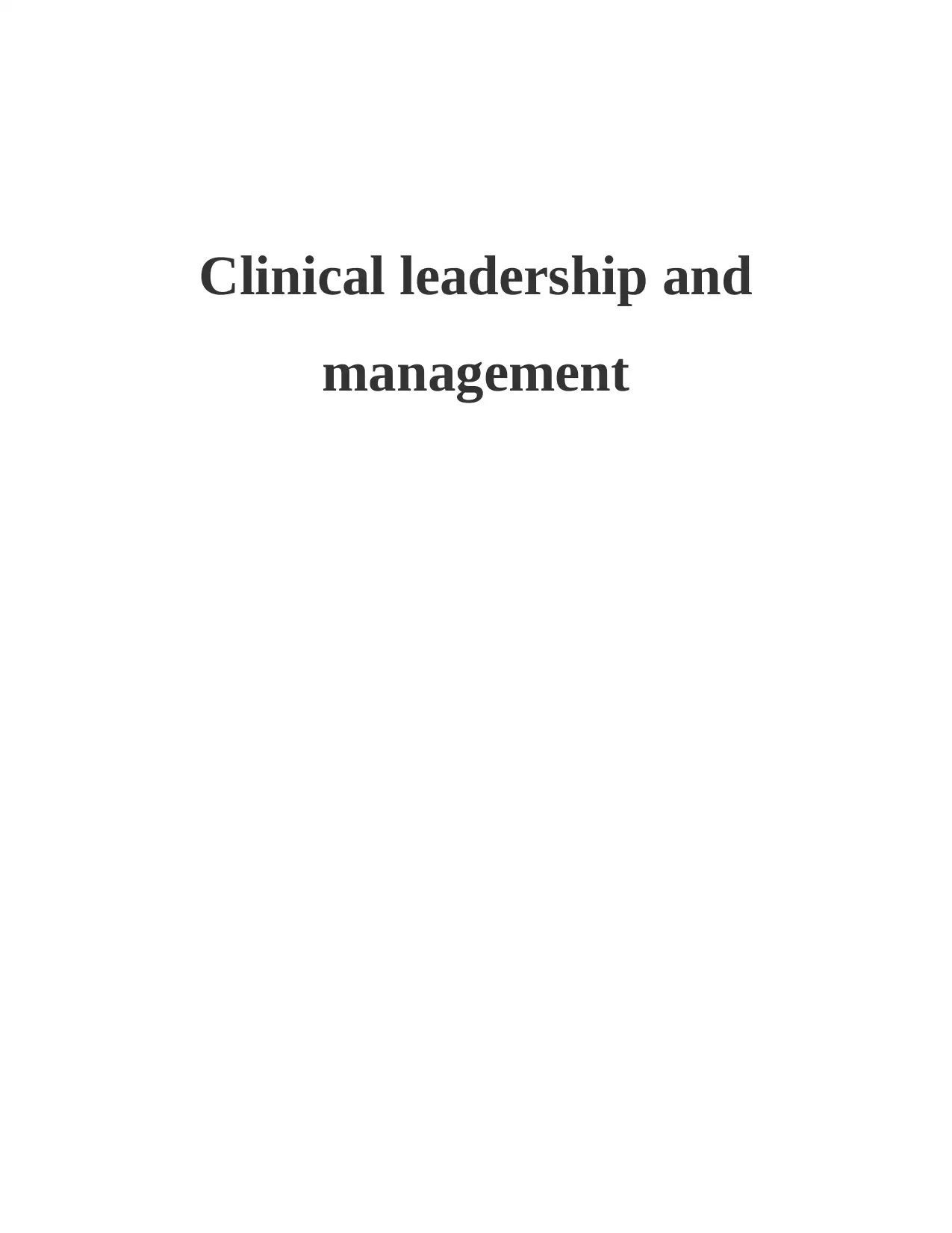
Clinical leadership and
management
management
Paraphrase This Document
Need a fresh take? Get an instant paraphrase of this document with our AI Paraphraser
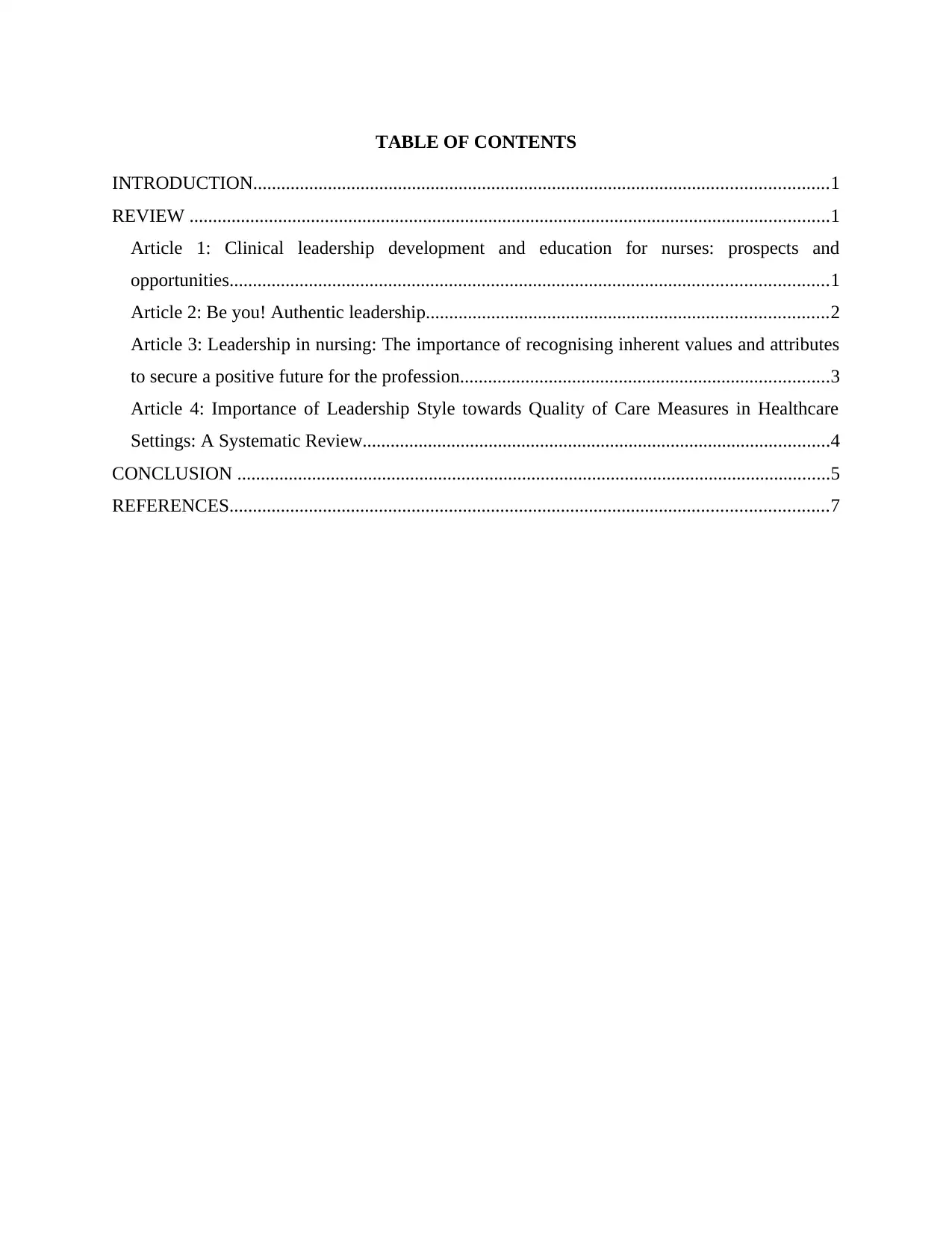
TABLE OF CONTENTS
INTRODUCTION...........................................................................................................................1
REVIEW .........................................................................................................................................1
Article 1: Clinical leadership development and education for nurses: prospects and
opportunities................................................................................................................................1
Article 2: Be you! Authentic leadership......................................................................................2
Article 3: Leadership in nursing: The importance of recognising inherent values and attributes
to secure a positive future for the profession...............................................................................3
Article 4: Importance of Leadership Style towards Quality of Care Measures in Healthcare
Settings: A Systematic Review....................................................................................................4
CONCLUSION ...............................................................................................................................5
REFERENCES................................................................................................................................7
INTRODUCTION...........................................................................................................................1
REVIEW .........................................................................................................................................1
Article 1: Clinical leadership development and education for nurses: prospects and
opportunities................................................................................................................................1
Article 2: Be you! Authentic leadership......................................................................................2
Article 3: Leadership in nursing: The importance of recognising inherent values and attributes
to secure a positive future for the profession...............................................................................3
Article 4: Importance of Leadership Style towards Quality of Care Measures in Healthcare
Settings: A Systematic Review....................................................................................................4
CONCLUSION ...............................................................................................................................5
REFERENCES................................................................................................................................7
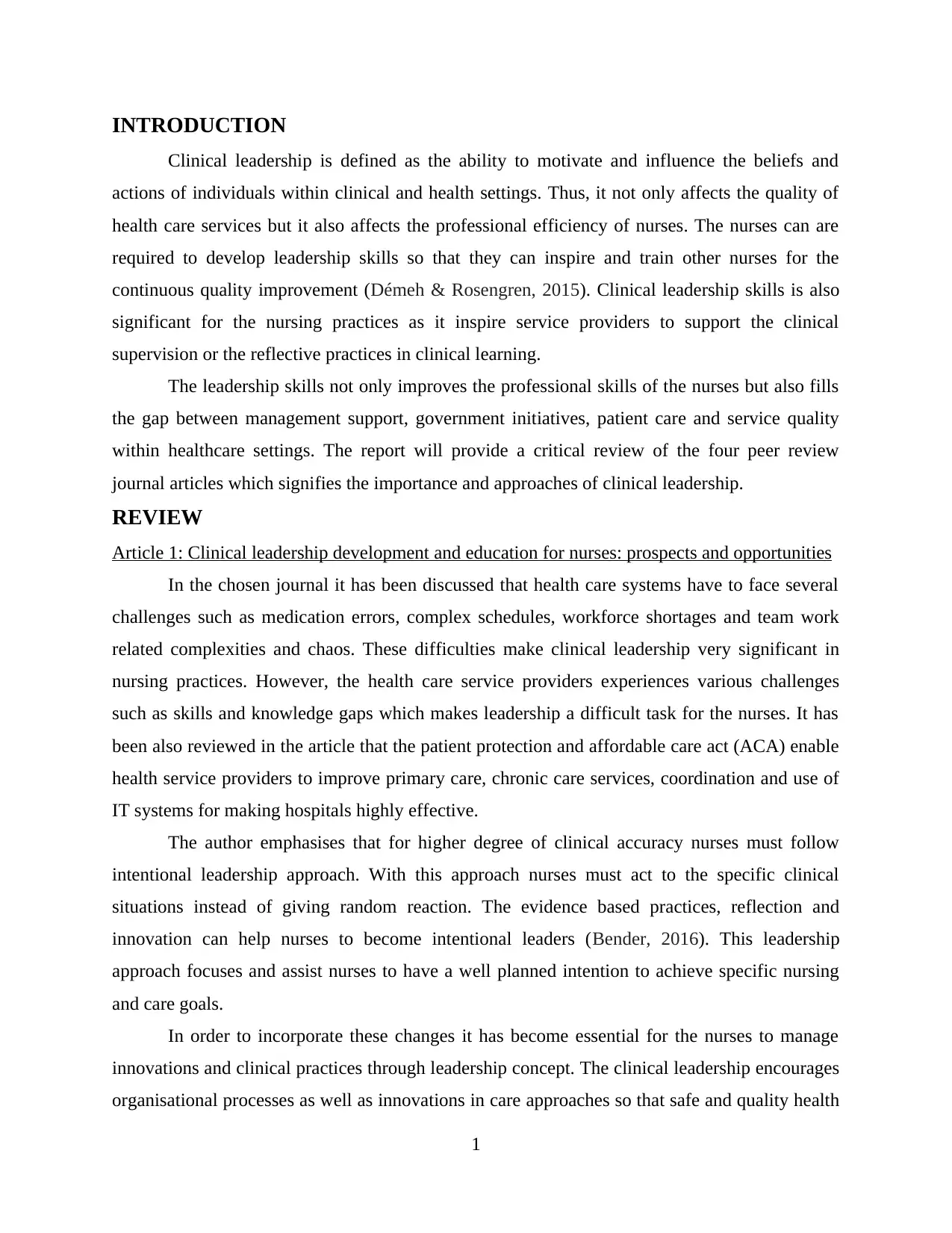
INTRODUCTION
Clinical leadership is defined as the ability to motivate and influence the beliefs and
actions of individuals within clinical and health settings. Thus, it not only affects the quality of
health care services but it also affects the professional efficiency of nurses. The nurses can are
required to develop leadership skills so that they can inspire and train other nurses for the
continuous quality improvement (Démeh & Rosengren, 2015). Clinical leadership skills is also
significant for the nursing practices as it inspire service providers to support the clinical
supervision or the reflective practices in clinical learning.
The leadership skills not only improves the professional skills of the nurses but also fills
the gap between management support, government initiatives, patient care and service quality
within healthcare settings. The report will provide a critical review of the four peer review
journal articles which signifies the importance and approaches of clinical leadership.
REVIEW
Article 1: Clinical leadership development and education for nurses: prospects and opportunities
In the chosen journal it has been discussed that health care systems have to face several
challenges such as medication errors, complex schedules, workforce shortages and team work
related complexities and chaos. These difficulties make clinical leadership very significant in
nursing practices. However, the health care service providers experiences various challenges
such as skills and knowledge gaps which makes leadership a difficult task for the nurses. It has
been also reviewed in the article that the patient protection and affordable care act (ACA) enable
health service providers to improve primary care, chronic care services, coordination and use of
IT systems for making hospitals highly effective.
The author emphasises that for higher degree of clinical accuracy nurses must follow
intentional leadership approach. With this approach nurses must act to the specific clinical
situations instead of giving random reaction. The evidence based practices, reflection and
innovation can help nurses to become intentional leaders (Bender, 2016). This leadership
approach focuses and assist nurses to have a well planned intention to achieve specific nursing
and care goals.
In order to incorporate these changes it has become essential for the nurses to manage
innovations and clinical practices through leadership concept. The clinical leadership encourages
organisational processes as well as innovations in care approaches so that safe and quality health
1
Clinical leadership is defined as the ability to motivate and influence the beliefs and
actions of individuals within clinical and health settings. Thus, it not only affects the quality of
health care services but it also affects the professional efficiency of nurses. The nurses can are
required to develop leadership skills so that they can inspire and train other nurses for the
continuous quality improvement (Démeh & Rosengren, 2015). Clinical leadership skills is also
significant for the nursing practices as it inspire service providers to support the clinical
supervision or the reflective practices in clinical learning.
The leadership skills not only improves the professional skills of the nurses but also fills
the gap between management support, government initiatives, patient care and service quality
within healthcare settings. The report will provide a critical review of the four peer review
journal articles which signifies the importance and approaches of clinical leadership.
REVIEW
Article 1: Clinical leadership development and education for nurses: prospects and opportunities
In the chosen journal it has been discussed that health care systems have to face several
challenges such as medication errors, complex schedules, workforce shortages and team work
related complexities and chaos. These difficulties make clinical leadership very significant in
nursing practices. However, the health care service providers experiences various challenges
such as skills and knowledge gaps which makes leadership a difficult task for the nurses. It has
been also reviewed in the article that the patient protection and affordable care act (ACA) enable
health service providers to improve primary care, chronic care services, coordination and use of
IT systems for making hospitals highly effective.
The author emphasises that for higher degree of clinical accuracy nurses must follow
intentional leadership approach. With this approach nurses must act to the specific clinical
situations instead of giving random reaction. The evidence based practices, reflection and
innovation can help nurses to become intentional leaders (Bender, 2016). This leadership
approach focuses and assist nurses to have a well planned intention to achieve specific nursing
and care goals.
In order to incorporate these changes it has become essential for the nurses to manage
innovations and clinical practices through leadership concept. The clinical leadership encourages
organisational processes as well as innovations in care approaches so that safe and quality health
1
⊘ This is a preview!⊘
Do you want full access?
Subscribe today to unlock all pages.

Trusted by 1+ million students worldwide
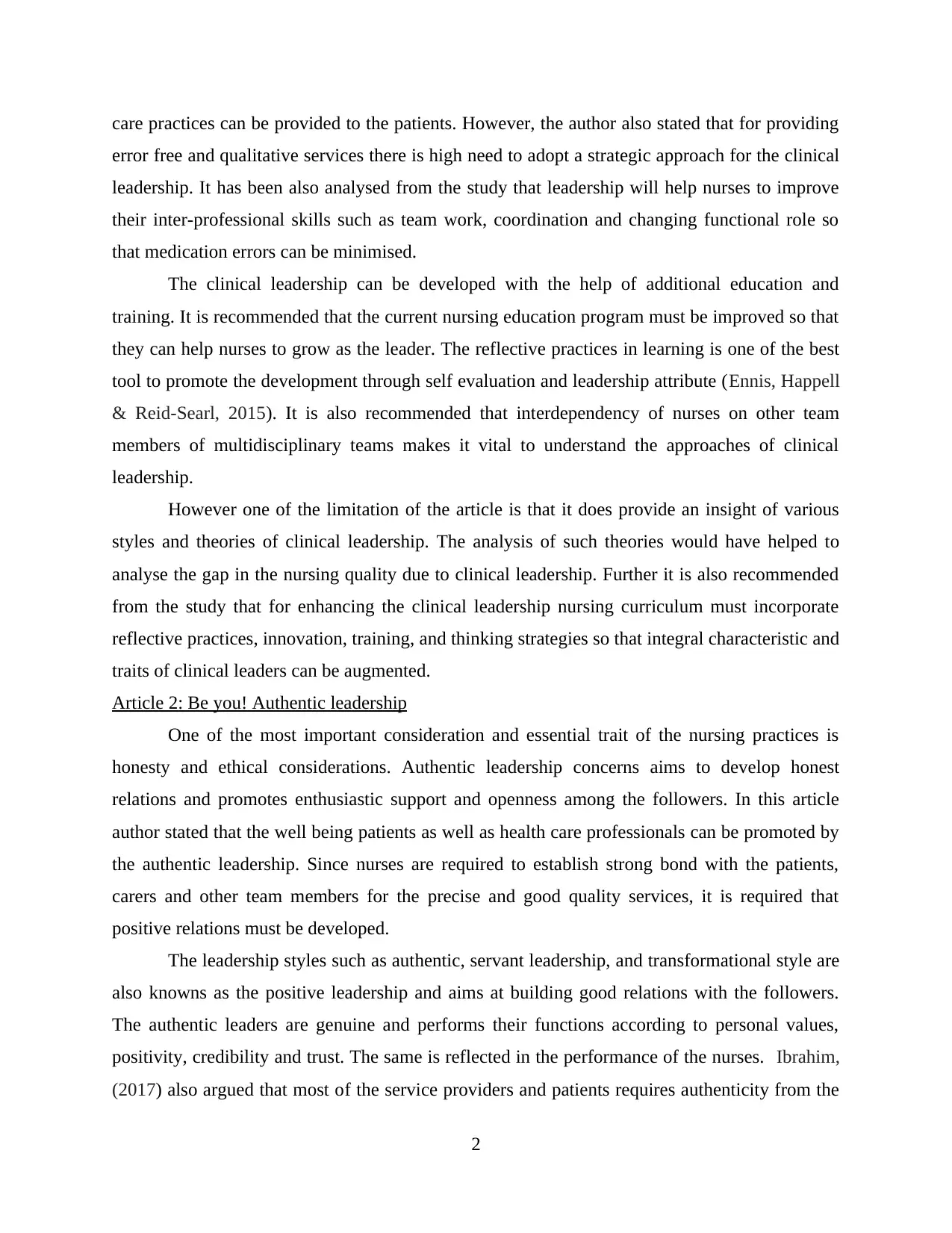
care practices can be provided to the patients. However, the author also stated that for providing
error free and qualitative services there is high need to adopt a strategic approach for the clinical
leadership. It has been also analysed from the study that leadership will help nurses to improve
their inter-professional skills such as team work, coordination and changing functional role so
that medication errors can be minimised.
The clinical leadership can be developed with the help of additional education and
training. It is recommended that the current nursing education program must be improved so that
they can help nurses to grow as the leader. The reflective practices in learning is one of the best
tool to promote the development through self evaluation and leadership attribute (Ennis, Happell
& Reid‐Searl, 2015). It is also recommended that interdependency of nurses on other team
members of multidisciplinary teams makes it vital to understand the approaches of clinical
leadership.
However one of the limitation of the article is that it does provide an insight of various
styles and theories of clinical leadership. The analysis of such theories would have helped to
analyse the gap in the nursing quality due to clinical leadership. Further it is also recommended
from the study that for enhancing the clinical leadership nursing curriculum must incorporate
reflective practices, innovation, training, and thinking strategies so that integral characteristic and
traits of clinical leaders can be augmented.
Article 2: Be you! Authentic leadership
One of the most important consideration and essential trait of the nursing practices is
honesty and ethical considerations. Authentic leadership concerns aims to develop honest
relations and promotes enthusiastic support and openness among the followers. In this article
author stated that the well being patients as well as health care professionals can be promoted by
the authentic leadership. Since nurses are required to establish strong bond with the patients,
carers and other team members for the precise and good quality services, it is required that
positive relations must be developed.
The leadership styles such as authentic, servant leadership, and transformational style are
also knowns as the positive leadership and aims at building good relations with the followers.
The authentic leaders are genuine and performs their functions according to personal values,
positivity, credibility and trust. The same is reflected in the performance of the nurses. Ibrahim,
(2017) also argued that most of the service providers and patients requires authenticity from the
2
error free and qualitative services there is high need to adopt a strategic approach for the clinical
leadership. It has been also analysed from the study that leadership will help nurses to improve
their inter-professional skills such as team work, coordination and changing functional role so
that medication errors can be minimised.
The clinical leadership can be developed with the help of additional education and
training. It is recommended that the current nursing education program must be improved so that
they can help nurses to grow as the leader. The reflective practices in learning is one of the best
tool to promote the development through self evaluation and leadership attribute (Ennis, Happell
& Reid‐Searl, 2015). It is also recommended that interdependency of nurses on other team
members of multidisciplinary teams makes it vital to understand the approaches of clinical
leadership.
However one of the limitation of the article is that it does provide an insight of various
styles and theories of clinical leadership. The analysis of such theories would have helped to
analyse the gap in the nursing quality due to clinical leadership. Further it is also recommended
from the study that for enhancing the clinical leadership nursing curriculum must incorporate
reflective practices, innovation, training, and thinking strategies so that integral characteristic and
traits of clinical leaders can be augmented.
Article 2: Be you! Authentic leadership
One of the most important consideration and essential trait of the nursing practices is
honesty and ethical considerations. Authentic leadership concerns aims to develop honest
relations and promotes enthusiastic support and openness among the followers. In this article
author stated that the well being patients as well as health care professionals can be promoted by
the authentic leadership. Since nurses are required to establish strong bond with the patients,
carers and other team members for the precise and good quality services, it is required that
positive relations must be developed.
The leadership styles such as authentic, servant leadership, and transformational style are
also knowns as the positive leadership and aims at building good relations with the followers.
The authentic leaders are genuine and performs their functions according to personal values,
positivity, credibility and trust. The same is reflected in the performance of the nurses. Ibrahim,
(2017) also argued that most of the service providers and patients requires authenticity from the
2
Paraphrase This Document
Need a fresh take? Get an instant paraphrase of this document with our AI Paraphraser
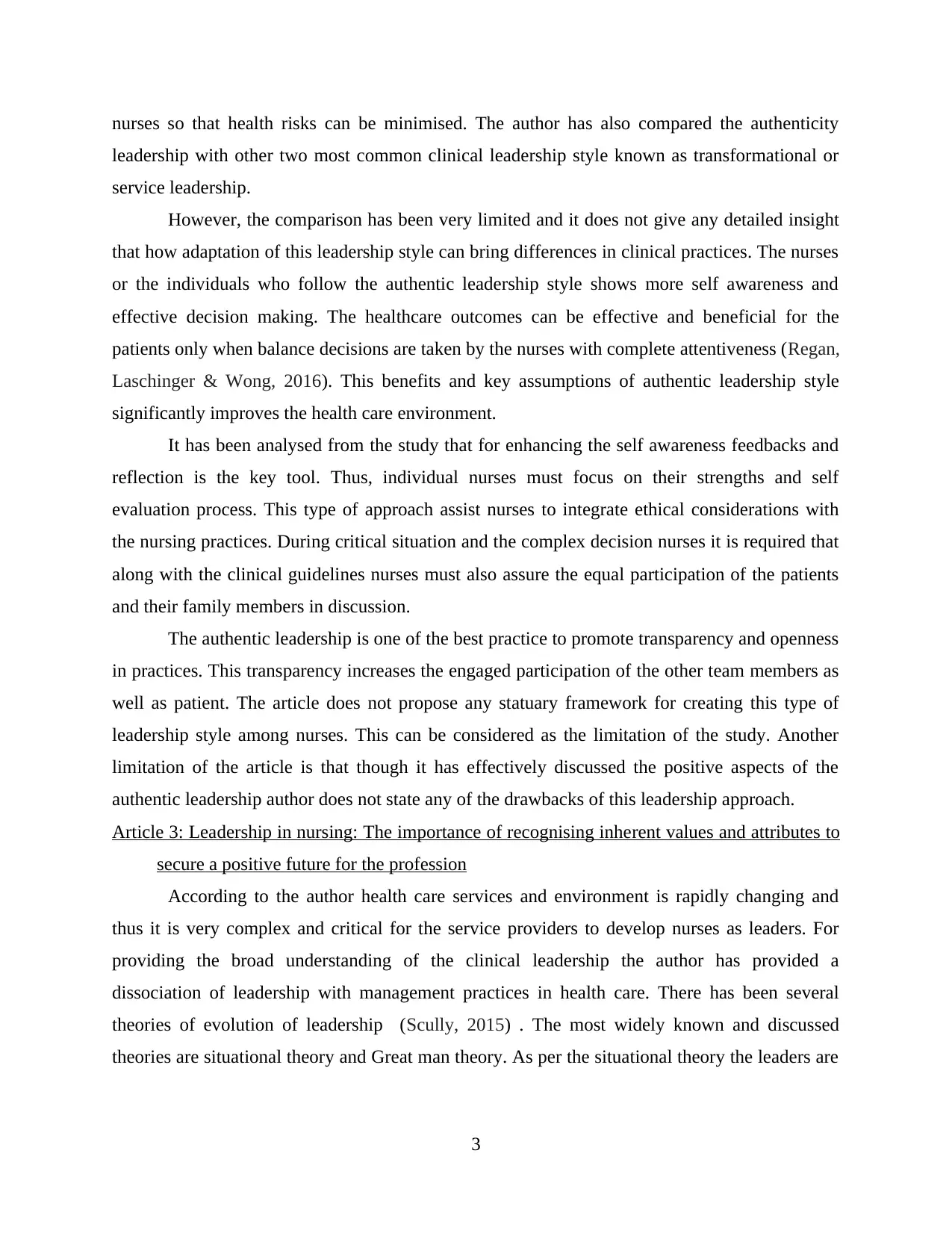
nurses so that health risks can be minimised. The author has also compared the authenticity
leadership with other two most common clinical leadership style known as transformational or
service leadership.
However, the comparison has been very limited and it does not give any detailed insight
that how adaptation of this leadership style can bring differences in clinical practices. The nurses
or the individuals who follow the authentic leadership style shows more self awareness and
effective decision making. The healthcare outcomes can be effective and beneficial for the
patients only when balance decisions are taken by the nurses with complete attentiveness (Regan,
Laschinger & Wong, 2016). This benefits and key assumptions of authentic leadership style
significantly improves the health care environment.
It has been analysed from the study that for enhancing the self awareness feedbacks and
reflection is the key tool. Thus, individual nurses must focus on their strengths and self
evaluation process. This type of approach assist nurses to integrate ethical considerations with
the nursing practices. During critical situation and the complex decision nurses it is required that
along with the clinical guidelines nurses must also assure the equal participation of the patients
and their family members in discussion.
The authentic leadership is one of the best practice to promote transparency and openness
in practices. This transparency increases the engaged participation of the other team members as
well as patient. The article does not propose any statuary framework for creating this type of
leadership style among nurses. This can be considered as the limitation of the study. Another
limitation of the article is that though it has effectively discussed the positive aspects of the
authentic leadership author does not state any of the drawbacks of this leadership approach.
Article 3: Leadership in nursing: The importance of recognising inherent values and attributes to
secure a positive future for the profession
According to the author health care services and environment is rapidly changing and
thus it is very complex and critical for the service providers to develop nurses as leaders. For
providing the broad understanding of the clinical leadership the author has provided a
dissociation of leadership with management practices in health care. There has been several
theories of evolution of leadership (Scully, 2015) . The most widely known and discussed
theories are situational theory and Great man theory. As per the situational theory the leaders are
3
leadership with other two most common clinical leadership style known as transformational or
service leadership.
However, the comparison has been very limited and it does not give any detailed insight
that how adaptation of this leadership style can bring differences in clinical practices. The nurses
or the individuals who follow the authentic leadership style shows more self awareness and
effective decision making. The healthcare outcomes can be effective and beneficial for the
patients only when balance decisions are taken by the nurses with complete attentiveness (Regan,
Laschinger & Wong, 2016). This benefits and key assumptions of authentic leadership style
significantly improves the health care environment.
It has been analysed from the study that for enhancing the self awareness feedbacks and
reflection is the key tool. Thus, individual nurses must focus on their strengths and self
evaluation process. This type of approach assist nurses to integrate ethical considerations with
the nursing practices. During critical situation and the complex decision nurses it is required that
along with the clinical guidelines nurses must also assure the equal participation of the patients
and their family members in discussion.
The authentic leadership is one of the best practice to promote transparency and openness
in practices. This transparency increases the engaged participation of the other team members as
well as patient. The article does not propose any statuary framework for creating this type of
leadership style among nurses. This can be considered as the limitation of the study. Another
limitation of the article is that though it has effectively discussed the positive aspects of the
authentic leadership author does not state any of the drawbacks of this leadership approach.
Article 3: Leadership in nursing: The importance of recognising inherent values and attributes to
secure a positive future for the profession
According to the author health care services and environment is rapidly changing and
thus it is very complex and critical for the service providers to develop nurses as leaders. For
providing the broad understanding of the clinical leadership the author has provided a
dissociation of leadership with management practices in health care. There has been several
theories of evolution of leadership (Scully, 2015) . The most widely known and discussed
theories are situational theory and Great man theory. As per the situational theory the leaders are
3
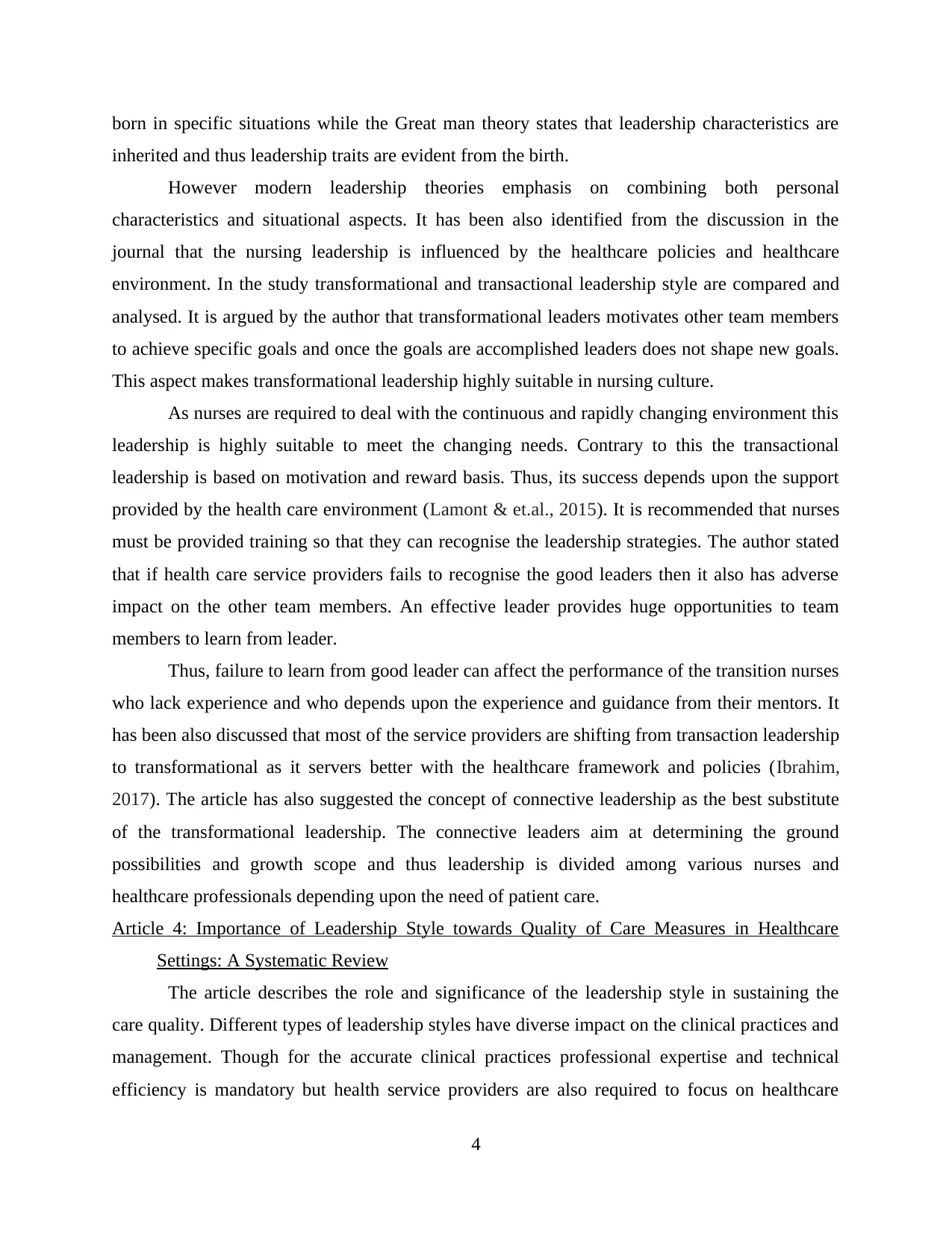
born in specific situations while the Great man theory states that leadership characteristics are
inherited and thus leadership traits are evident from the birth.
However modern leadership theories emphasis on combining both personal
characteristics and situational aspects. It has been also identified from the discussion in the
journal that the nursing leadership is influenced by the healthcare policies and healthcare
environment. In the study transformational and transactional leadership style are compared and
analysed. It is argued by the author that transformational leaders motivates other team members
to achieve specific goals and once the goals are accomplished leaders does not shape new goals.
This aspect makes transformational leadership highly suitable in nursing culture.
As nurses are required to deal with the continuous and rapidly changing environment this
leadership is highly suitable to meet the changing needs. Contrary to this the transactional
leadership is based on motivation and reward basis. Thus, its success depends upon the support
provided by the health care environment (Lamont & et.al., 2015). It is recommended that nurses
must be provided training so that they can recognise the leadership strategies. The author stated
that if health care service providers fails to recognise the good leaders then it also has adverse
impact on the other team members. An effective leader provides huge opportunities to team
members to learn from leader.
Thus, failure to learn from good leader can affect the performance of the transition nurses
who lack experience and who depends upon the experience and guidance from their mentors. It
has been also discussed that most of the service providers are shifting from transaction leadership
to transformational as it servers better with the healthcare framework and policies (Ibrahim,
2017). The article has also suggested the concept of connective leadership as the best substitute
of the transformational leadership. The connective leaders aim at determining the ground
possibilities and growth scope and thus leadership is divided among various nurses and
healthcare professionals depending upon the need of patient care.
Article 4: Importance of Leadership Style towards Quality of Care Measures in Healthcare
Settings: A Systematic Review
The article describes the role and significance of the leadership style in sustaining the
care quality. Different types of leadership styles have diverse impact on the clinical practices and
management. Though for the accurate clinical practices professional expertise and technical
efficiency is mandatory but health service providers are also required to focus on healthcare
4
inherited and thus leadership traits are evident from the birth.
However modern leadership theories emphasis on combining both personal
characteristics and situational aspects. It has been also identified from the discussion in the
journal that the nursing leadership is influenced by the healthcare policies and healthcare
environment. In the study transformational and transactional leadership style are compared and
analysed. It is argued by the author that transformational leaders motivates other team members
to achieve specific goals and once the goals are accomplished leaders does not shape new goals.
This aspect makes transformational leadership highly suitable in nursing culture.
As nurses are required to deal with the continuous and rapidly changing environment this
leadership is highly suitable to meet the changing needs. Contrary to this the transactional
leadership is based on motivation and reward basis. Thus, its success depends upon the support
provided by the health care environment (Lamont & et.al., 2015). It is recommended that nurses
must be provided training so that they can recognise the leadership strategies. The author stated
that if health care service providers fails to recognise the good leaders then it also has adverse
impact on the other team members. An effective leader provides huge opportunities to team
members to learn from leader.
Thus, failure to learn from good leader can affect the performance of the transition nurses
who lack experience and who depends upon the experience and guidance from their mentors. It
has been also discussed that most of the service providers are shifting from transaction leadership
to transformational as it servers better with the healthcare framework and policies (Ibrahim,
2017). The article has also suggested the concept of connective leadership as the best substitute
of the transformational leadership. The connective leaders aim at determining the ground
possibilities and growth scope and thus leadership is divided among various nurses and
healthcare professionals depending upon the need of patient care.
Article 4: Importance of Leadership Style towards Quality of Care Measures in Healthcare
Settings: A Systematic Review
The article describes the role and significance of the leadership style in sustaining the
care quality. Different types of leadership styles have diverse impact on the clinical practices and
management. Though for the accurate clinical practices professional expertise and technical
efficiency is mandatory but health service providers are also required to focus on healthcare
4
⊘ This is a preview!⊘
Do you want full access?
Subscribe today to unlock all pages.

Trusted by 1+ million students worldwide
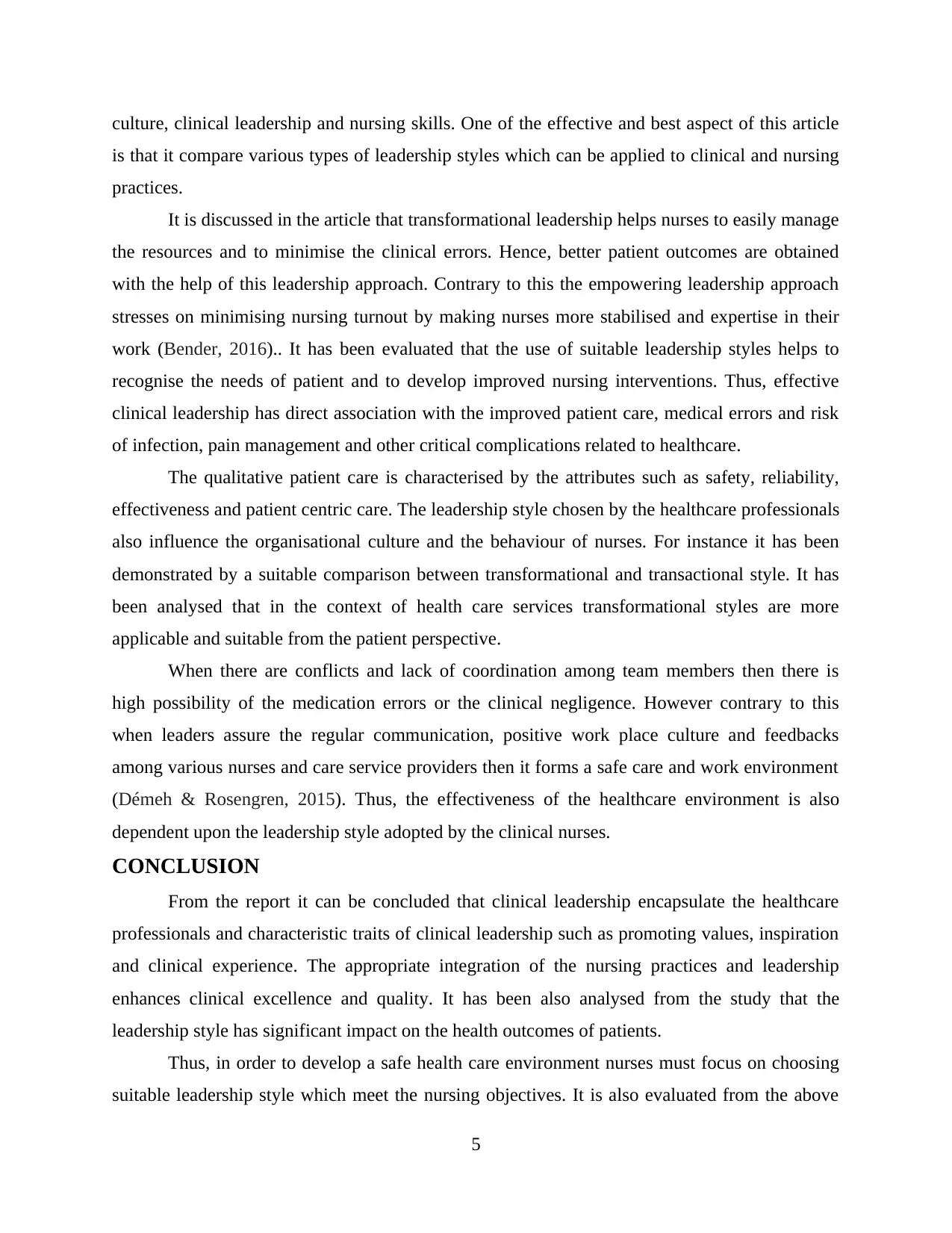
culture, clinical leadership and nursing skills. One of the effective and best aspect of this article
is that it compare various types of leadership styles which can be applied to clinical and nursing
practices.
It is discussed in the article that transformational leadership helps nurses to easily manage
the resources and to minimise the clinical errors. Hence, better patient outcomes are obtained
with the help of this leadership approach. Contrary to this the empowering leadership approach
stresses on minimising nursing turnout by making nurses more stabilised and expertise in their
work (Bender, 2016).. It has been evaluated that the use of suitable leadership styles helps to
recognise the needs of patient and to develop improved nursing interventions. Thus, effective
clinical leadership has direct association with the improved patient care, medical errors and risk
of infection, pain management and other critical complications related to healthcare.
The qualitative patient care is characterised by the attributes such as safety, reliability,
effectiveness and patient centric care. The leadership style chosen by the healthcare professionals
also influence the organisational culture and the behaviour of nurses. For instance it has been
demonstrated by a suitable comparison between transformational and transactional style. It has
been analysed that in the context of health care services transformational styles are more
applicable and suitable from the patient perspective.
When there are conflicts and lack of coordination among team members then there is
high possibility of the medication errors or the clinical negligence. However contrary to this
when leaders assure the regular communication, positive work place culture and feedbacks
among various nurses and care service providers then it forms a safe care and work environment
(Démeh & Rosengren, 2015). Thus, the effectiveness of the healthcare environment is also
dependent upon the leadership style adopted by the clinical nurses.
CONCLUSION
From the report it can be concluded that clinical leadership encapsulate the healthcare
professionals and characteristic traits of clinical leadership such as promoting values, inspiration
and clinical experience. The appropriate integration of the nursing practices and leadership
enhances clinical excellence and quality. It has been also analysed from the study that the
leadership style has significant impact on the health outcomes of patients.
Thus, in order to develop a safe health care environment nurses must focus on choosing
suitable leadership style which meet the nursing objectives. It is also evaluated from the above
5
is that it compare various types of leadership styles which can be applied to clinical and nursing
practices.
It is discussed in the article that transformational leadership helps nurses to easily manage
the resources and to minimise the clinical errors. Hence, better patient outcomes are obtained
with the help of this leadership approach. Contrary to this the empowering leadership approach
stresses on minimising nursing turnout by making nurses more stabilised and expertise in their
work (Bender, 2016).. It has been evaluated that the use of suitable leadership styles helps to
recognise the needs of patient and to develop improved nursing interventions. Thus, effective
clinical leadership has direct association with the improved patient care, medical errors and risk
of infection, pain management and other critical complications related to healthcare.
The qualitative patient care is characterised by the attributes such as safety, reliability,
effectiveness and patient centric care. The leadership style chosen by the healthcare professionals
also influence the organisational culture and the behaviour of nurses. For instance it has been
demonstrated by a suitable comparison between transformational and transactional style. It has
been analysed that in the context of health care services transformational styles are more
applicable and suitable from the patient perspective.
When there are conflicts and lack of coordination among team members then there is
high possibility of the medication errors or the clinical negligence. However contrary to this
when leaders assure the regular communication, positive work place culture and feedbacks
among various nurses and care service providers then it forms a safe care and work environment
(Démeh & Rosengren, 2015). Thus, the effectiveness of the healthcare environment is also
dependent upon the leadership style adopted by the clinical nurses.
CONCLUSION
From the report it can be concluded that clinical leadership encapsulate the healthcare
professionals and characteristic traits of clinical leadership such as promoting values, inspiration
and clinical experience. The appropriate integration of the nursing practices and leadership
enhances clinical excellence and quality. It has been also analysed from the study that the
leadership style has significant impact on the health outcomes of patients.
Thus, in order to develop a safe health care environment nurses must focus on choosing
suitable leadership style which meet the nursing objectives. It is also evaluated from the above
5
Paraphrase This Document
Need a fresh take? Get an instant paraphrase of this document with our AI Paraphraser

discussion that in health care services team work is also one of the integral element of the
functioning. Thus, leadership skills helps nurses to develop and improve their decision making,
team work and risk engagement skills so that clinical errors can be minimised.
6
functioning. Thus, leadership skills helps nurses to develop and improve their decision making,
team work and risk engagement skills so that clinical errors can be minimised.
6
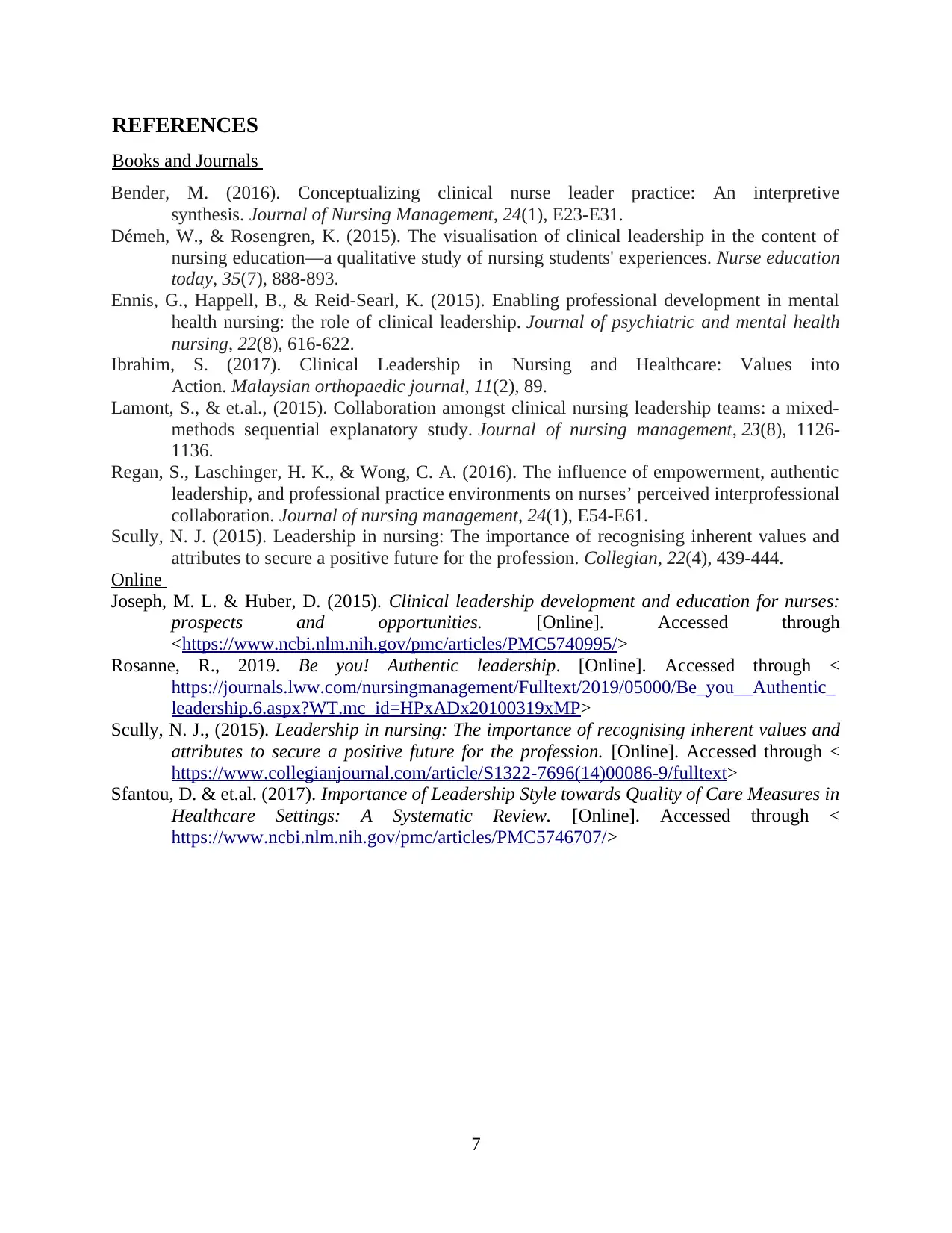
REFERENCES
Books and Journals
Bender, M. (2016). Conceptualizing clinical nurse leader practice: An interpretive
synthesis. Journal of Nursing Management, 24(1), E23-E31.
Démeh, W., & Rosengren, K. (2015). The visualisation of clinical leadership in the content of
nursing education—a qualitative study of nursing students' experiences. Nurse education
today, 35(7), 888-893.
Ennis, G., Happell, B., & Reid‐Searl, K. (2015). Enabling professional development in mental
health nursing: the role of clinical leadership. Journal of psychiatric and mental health
nursing, 22(8), 616-622.
Ibrahim, S. (2017). Clinical Leadership in Nursing and Healthcare: Values into
Action. Malaysian orthopaedic journal, 11(2), 89.
Lamont, S., & et.al., (2015). Collaboration amongst clinical nursing leadership teams: a mixed‐
methods sequential explanatory study. Journal of nursing management, 23(8), 1126-
1136.
Regan, S., Laschinger, H. K., & Wong, C. A. (2016). The influence of empowerment, authentic
leadership, and professional practice environments on nurses’ perceived interprofessional
collaboration. Journal of nursing management, 24(1), E54-E61.
Scully, N. J. (2015). Leadership in nursing: The importance of recognising inherent values and
attributes to secure a positive future for the profession. Collegian, 22(4), 439-444.
Online
Joseph, M. L. & Huber, D. (2015). Clinical leadership development and education for nurses:
prospects and opportunities. [Online]. Accessed through
<https://www.ncbi.nlm.nih.gov/pmc/articles/PMC5740995/>
Rosanne, R., 2019. Be you! Authentic leadership. [Online]. Accessed through <
https://journals.lww.com/nursingmanagement/Fulltext/2019/05000/Be_you__Authentic_
leadership.6.aspx?WT.mc_id=HPxADx20100319xMP>
Scully, N. J., (2015). Leadership in nursing: The importance of recognising inherent values and
attributes to secure a positive future for the profession. [Online]. Accessed through <
https://www.collegianjournal.com/article/S1322-7696(14)00086-9/fulltext>
Sfantou, D. & et.al. (2017). Importance of Leadership Style towards Quality of Care Measures in
Healthcare Settings: A Systematic Review. [Online]. Accessed through <
https://www.ncbi.nlm.nih.gov/pmc/articles/PMC5746707/>
7
Books and Journals
Bender, M. (2016). Conceptualizing clinical nurse leader practice: An interpretive
synthesis. Journal of Nursing Management, 24(1), E23-E31.
Démeh, W., & Rosengren, K. (2015). The visualisation of clinical leadership in the content of
nursing education—a qualitative study of nursing students' experiences. Nurse education
today, 35(7), 888-893.
Ennis, G., Happell, B., & Reid‐Searl, K. (2015). Enabling professional development in mental
health nursing: the role of clinical leadership. Journal of psychiatric and mental health
nursing, 22(8), 616-622.
Ibrahim, S. (2017). Clinical Leadership in Nursing and Healthcare: Values into
Action. Malaysian orthopaedic journal, 11(2), 89.
Lamont, S., & et.al., (2015). Collaboration amongst clinical nursing leadership teams: a mixed‐
methods sequential explanatory study. Journal of nursing management, 23(8), 1126-
1136.
Regan, S., Laschinger, H. K., & Wong, C. A. (2016). The influence of empowerment, authentic
leadership, and professional practice environments on nurses’ perceived interprofessional
collaboration. Journal of nursing management, 24(1), E54-E61.
Scully, N. J. (2015). Leadership in nursing: The importance of recognising inherent values and
attributes to secure a positive future for the profession. Collegian, 22(4), 439-444.
Online
Joseph, M. L. & Huber, D. (2015). Clinical leadership development and education for nurses:
prospects and opportunities. [Online]. Accessed through
<https://www.ncbi.nlm.nih.gov/pmc/articles/PMC5740995/>
Rosanne, R., 2019. Be you! Authentic leadership. [Online]. Accessed through <
https://journals.lww.com/nursingmanagement/Fulltext/2019/05000/Be_you__Authentic_
leadership.6.aspx?WT.mc_id=HPxADx20100319xMP>
Scully, N. J., (2015). Leadership in nursing: The importance of recognising inherent values and
attributes to secure a positive future for the profession. [Online]. Accessed through <
https://www.collegianjournal.com/article/S1322-7696(14)00086-9/fulltext>
Sfantou, D. & et.al. (2017). Importance of Leadership Style towards Quality of Care Measures in
Healthcare Settings: A Systematic Review. [Online]. Accessed through <
https://www.ncbi.nlm.nih.gov/pmc/articles/PMC5746707/>
7
⊘ This is a preview!⊘
Do you want full access?
Subscribe today to unlock all pages.

Trusted by 1+ million students worldwide

8
Paraphrase This Document
Need a fresh take? Get an instant paraphrase of this document with our AI Paraphraser

9

10
⊘ This is a preview!⊘
Do you want full access?
Subscribe today to unlock all pages.

Trusted by 1+ million students worldwide
1 out of 14
Related Documents
Your All-in-One AI-Powered Toolkit for Academic Success.
+13062052269
info@desklib.com
Available 24*7 on WhatsApp / Email
![[object Object]](/_next/static/media/star-bottom.7253800d.svg)
Unlock your academic potential
Copyright © 2020–2025 A2Z Services. All Rights Reserved. Developed and managed by ZUCOL.





